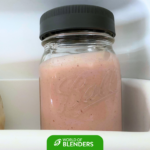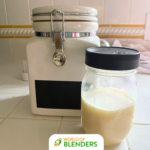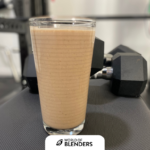This post may contain affiliate links. If you use these links to buy something we may earn a small commission. Thanks.
I’ve been powerlifting for years and drink protein shakes almost every single day of the week!
It’s best to make protein shakes with milk or water because they’re healthy, easy to mix, and dirt cheap.
I’ve made hundreds of protein shakes and I’ve gotta be honest, milk is the winner for me. It’s creamier, tastes better, and gives the protein shake the perfect thickness.
Water is great if you’re in a hurry and don’t want to add any liquid calories to your shake.
I’ll run through the differences between using milk or water in protein shakes so you can decide for yourself!
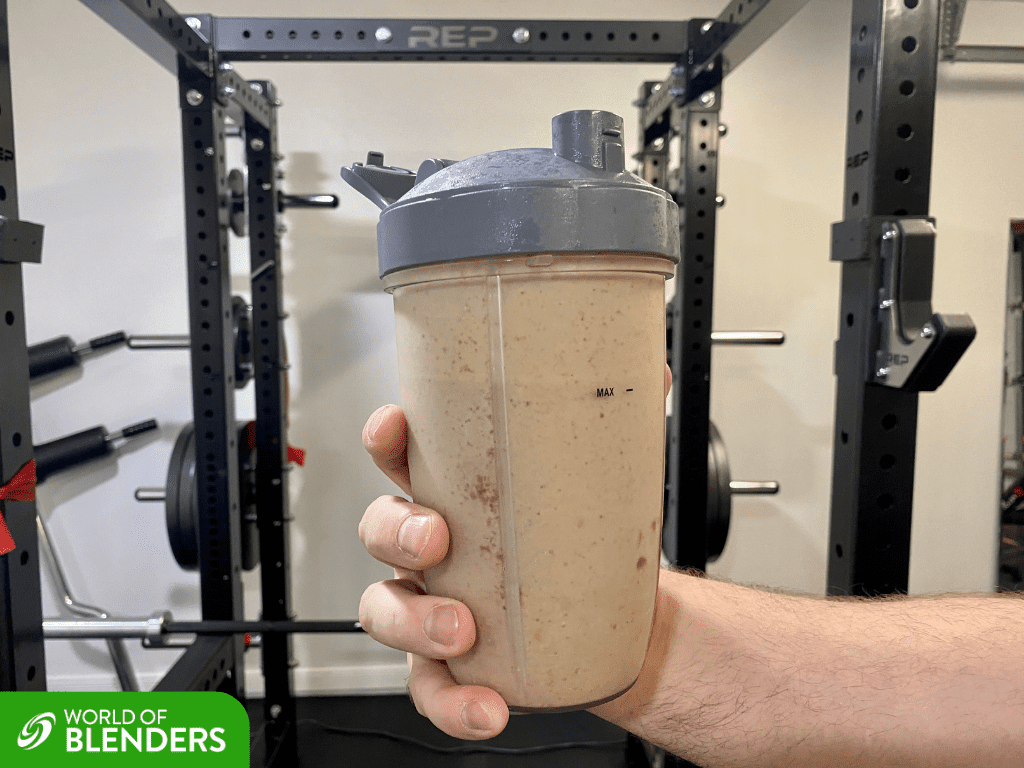
Protein Shake with Milk or Water: Which is Better?
I put together a list of 7 key factors in deciding if you should make a protein shake with milk or water. It really just comes down to what you care about most!
| Protein Shake with Milk | Protein Shake with Water | |
| Nutrition | Adds protein, carbs, and fats | Does not add any nutritional value |
| Calories | Adds calories. 1 cup (240ml) of whole milk adds around 150 calories. | Does not add calories |
| Thickness | Thicker and creamier | Very thin with no creaminess |
| Taste | Adds sweet taste | Does not add taste |
| Digestion | Slow to digest and can cause gas and bloating | Quick and east to digest |
| Absorption | Slow to absorb, delaying protein getting to muscles | Absorbs quickly, getting protein to muscles sooner |
| Mixing | More likely to clump | Less likely to clump |
As you can see, both milk and water have their advantages and disadvantages. Whether milk or water is best for you will depend on your personal preferences and fitness goals.
KEY TAKEAWAYS
- Gaining mass – Milk would be best as it adds even more protein along with other nutrients.
- Low calories – Water is zero calories so it’s the best option if you’re trying to lose weight.
- Quick digesting – Water doesn’t increase digestion time, but milk takes longer to digest.
- Workout recovery – Drinking milk will help with workout recovery because of the extra calories and protein.
- Consistency – Milk is the winner here because it’s creamier and slightly thicker!
In terms of taste and consistency, mixing protein powder with milk is a great way to make a protein shake thicker! On the other hand, you’ll find that water is best if enjoy a thinner shake and like the taste of your protein powder.
What are the benefits of drinking a protein shake with milk?
The benefits of drinking a protein shake with milk are…
- Extra protein, fats, and carbohydrates.
- Vitamin D and calcium, which help to maintain strong bones.
- More calories, which is an advantage if you want to gain mass.
- Casein protein, as well as whey protein, which gives your muscles a slow and steady supply of amino acids.
- Thick and creamy smoothie-like texture.
- Sweet taste that can help to hide the chalky taste of protein powder.
What are the benefits of drinking a protein shake with water?
The benefits of drinking a protein shake with water are…
- No calories and no fat, which is a benefit if you want to maintain or lose weight.
- Easier to digest with less gas and bloating.
- Absorbed more quickly, so amino acids get to the muscles sooner, which aids recovery.
- Less likely to clump when mixing.
- Does not affect the taste of your shake, which is an advantage if you want the flavor to come from other ingredients.
Protein Shake with Milk
The table above is a summary, but I thought it’d be helpful to do a deep dive on the benefits of using milk for protein shakes.
Milk will make it creamier which is one of the easiest ways to make a protein shake taste better.
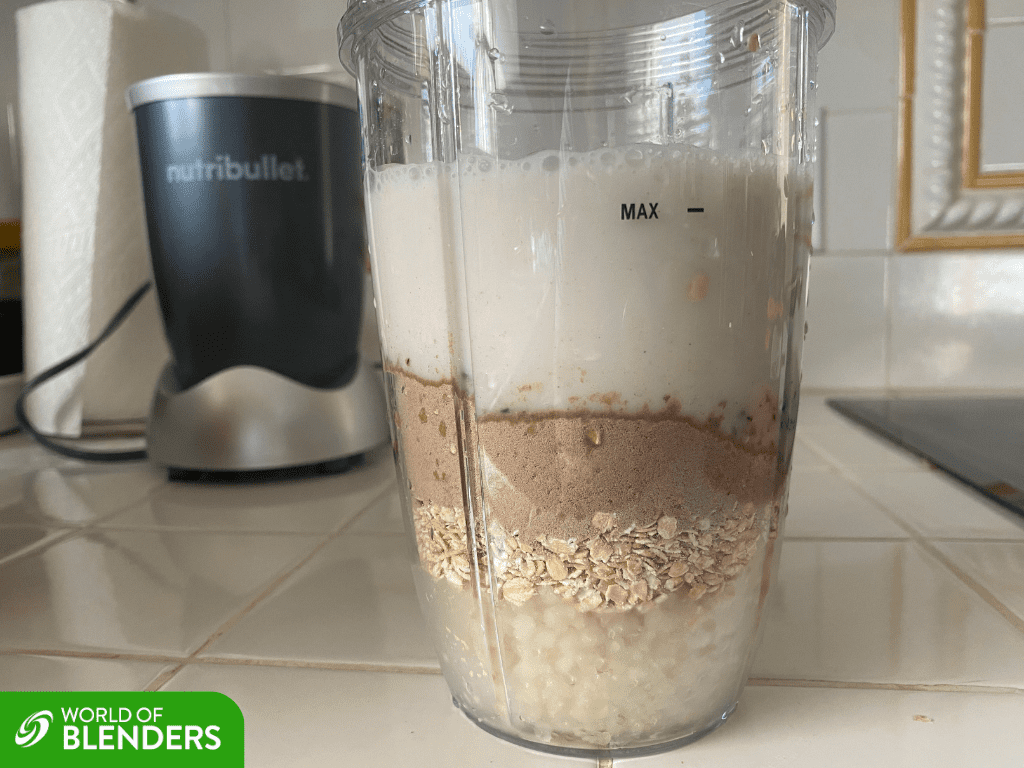
Nutrition
Milk contains protein, carbohydrates, and fats, as well as vitamin D and calcium, which are great for maintaining strong and healthy bones.
By mixing your protein powder with milk, you can significantly increase the protein content of your shake. One cup (240ml) of 2% milk will add approximately 8 grams of protein on top of the protein that is already contained within your protein powder.
Calories
Using milk as the liquid base of your shake can add a significant number of calories in protein shakes, depending on the type and quantity of milk you use. The table below shows approximate calorie counts for one cup (240ml) of different types of milk.
A lot of our protein shakes for weight gain use milk as the base liquid!
The reason we prefer to use milk is because you can get all the benefits of milk with low calories if you use 1% or a dairy free option like almond milk.
| Type of Milk | Approximate Calorie Count Per Cup (240ml) |
| Whole milk | 150 |
| Oat milk | 125 |
| 2% milk | 120 |
| 1% milk | 100 |
| Soy milk | 90 |
| Skimmed milk | 80 |
| Coconut milk | 50 |
| Almond milk | 35 |
Thickness
Milk is thicker than water so mixing your protein powder with milk will give your shake a much thicker and creamier texture, a bit like a smoothie. Whether you want a thick shake is a matter of personal preference, and you can adjust the amount and type of milk to make your shake thicker or thinner.
Taste
Mixing your protein shake with cow’s milk will add a sweet, creamy taste. Other types of milk will add different tastes, so it’s a good idea to explore plant-based milk and discover new flavors.
An advantage of using milk in your protein shake is that it can help to hide the taste of the protein powder, which doesn’t always taste great and can often have an unpleasant chalky taste. You can freeze protein shakes for a few months, but sometimes they won’t taste as good.
Digestion
Milk can cause digestion problems for many people, particularly those with an intolerance to lactose. Even if you are not lactose intolerant, milk can be difficult for the body to digest, which can lead to gas and a bloated feeling.
If you struggle to digest dairy milk then you may want to consider trying a lactose-free plant-based alternative. The best milk for whey protein is probably skim or 2% milk!
Absorption
Absorption is the process of nutrients passing out of the intestines and into the blood. After a workout, it’s important to get amino acids to your muscles as quickly as possible to aid recovery. Protein contained within a milk-based shake is absorbed more slowly compared to protein in a water-based shake, which means the amino acids will not reach the muscles as quickly.
Milk does however give your muscles a slow and steady supply of amino acids. This is because milk contains both whey protein, which is absorbed quickly, and casein protein, which is absorbed slowly.
Mixing
Mixing protein powder with milk is usually easy, as it is with water. However, milk does have more of a tendency to cause clumping. This is because milk contains casein protein, which is prone to clumping when mixed with other types of protein. There are all kinds of ingredients to mix with protein powder to add more flavor!
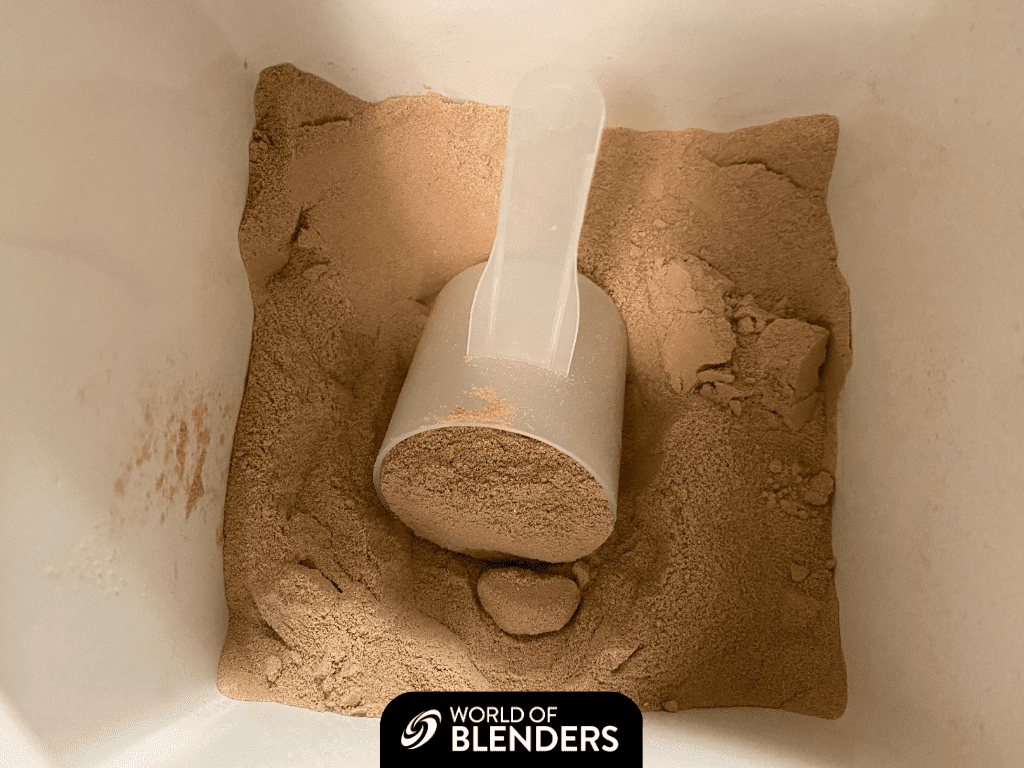
Protein Shake with Water
What kind of protein shake do you get when you mix your protein powder with water? Find out how choosing water will affect the nutritional value and taste and texture of your shake, as well as the rate that the protein is absorbed by your body.
Nutrition
Water does not add any nutritional value to your protein shake. Unlike milk, water doesn’t contain protein, carbohydrates, fats, or calcium. This can either be a positive or a negative, depending on your personal health and fitness goals.
Water will help your protein shakes last longer in the fridge or if you want to make a protein shake the night before you can just give it a quick shake!
Calories
Water does not add any calories to your protein shake. This makes water an appealing choice if you are looking to lose weight or limit your calorie intake to maintain your current weight. However, if you want to gain mass, then milk may be the better choice, as it can significantly increase your shake’s calorie content.
A lot of our low calorie protein shakes use water as the base liquid!
Thickness
Water is thinner than milk, so a protein shake made with water will not be as thick as one made with milk.
If you want a thicker shake, then you will either need to use milk instead of water or add thickening ingredients (chia seeds, for example) in order to thicken your water-based protein shake.
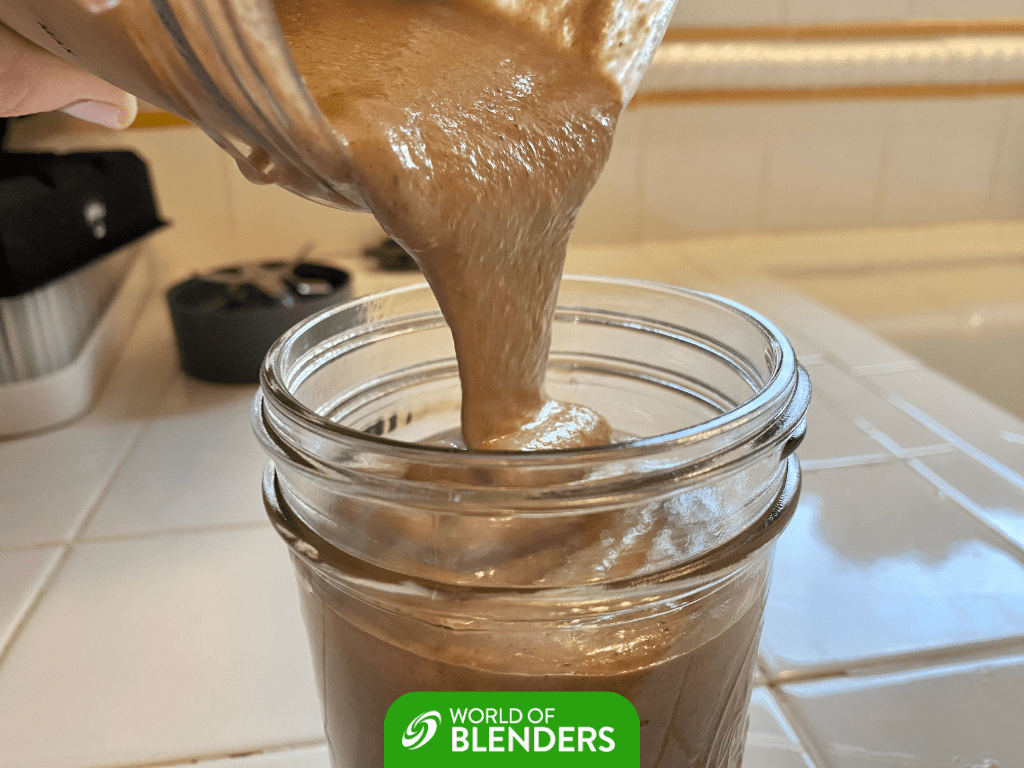
Taste
Water will not add any noticeable taste to your protein shake. A protein shake mixed with water will therefore taste like the protein powder and any other ingredients you choose to add to your shake.
Digestion
Water is easier to digest than milk, so protein shakes made with water will be digested more quickly and with fewer problems, such as gas or bloating. This is particularly true if you are lactose intolerant.
If you do have an intolerance to lactose, or find that milk causes digestion issues, then I recommend mixing your protein shake with water or a plant-based milk alternative.
Absorption
The nutrients within a water-based protein shake will be absorbed into your bloodstream more quickly than the nutrients in a milky protein shake. This means that amino acids will reach your muscles more quickly and help to repair them sooner if you choose to mix your shake with water rather than with milk.
Mixing
Mixing protein powder with water is quick and easy. Simply give the powder a vigorous shake and stir using either a shaker bottle or a blender. Compared to milk, protein powder is less likely to clump when mixed with water. If you want to mix protein shakes without a shaker then water is your best bet!
Common Questions about Mixing Protein Shake with Milk or Water
Whether it is better to mix protein powder with milk or water depends on your fitness goals and personal taste. Milk makes your shake thicker and is best for nutritional value, strengthening bones, and gaining mass. Water is best if you want a low-calorie, thinner protein shake, and your priority is getting amino acids to your muscles quickly to aid recovery.
You can mix any type of milk with protein powder. Popular choices include dairy milk, almond milk, soy milk, coconut milk, and oat milk. Plant-based milk is a good alternative to cow’s milk if you are vegan, lactose intolerant, or simply prefer the texture and flavor.
Generally speaking, you should mix 6 to 12 ounces of milk per scoop of protein powder. However, the amount of milk you use depends on what consistency you want your protein shake to be. You should therefore experiment with different amounts of milk to find the right balance for your tastes.
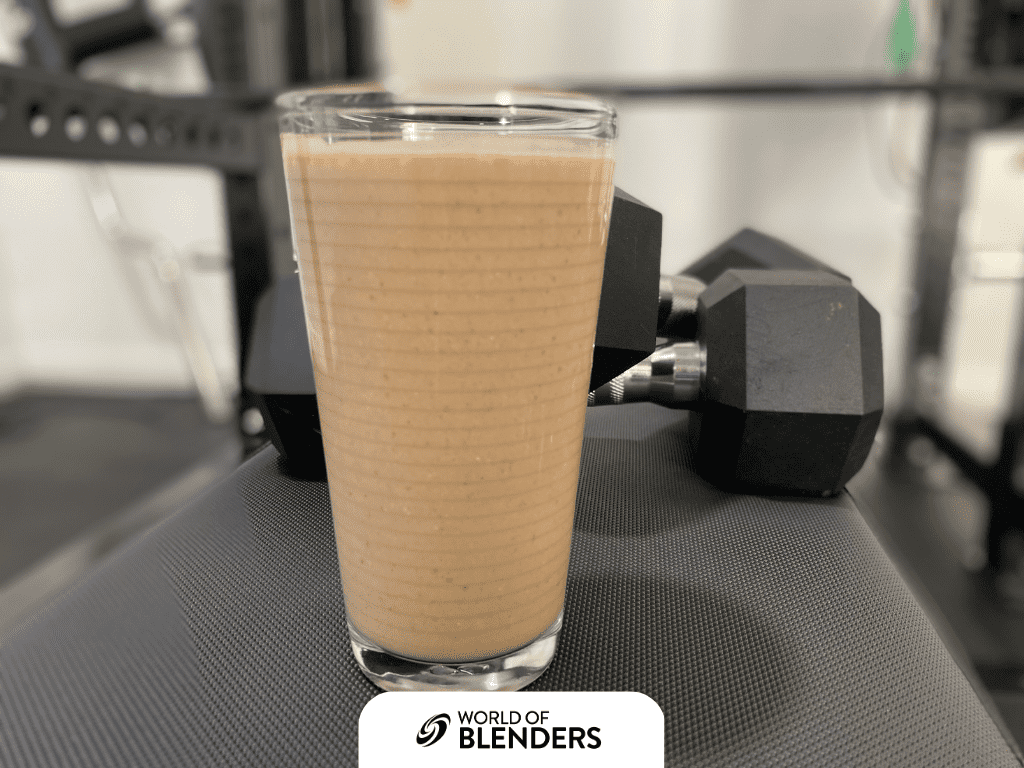
Our Verdict: Protein Shake With Milk or Water… Which Should You Choose?
If you’re drinking shakes regularly, I recommend making your protein shakes with milk or water depending on your fitness goals.
- Water – Best for low calories, mixability, and convenience.
- Milk – Best for taste, texture, and added calories for workout recovery.
You can always change it up depending on what you’re in the mood for or what your fitness goals are!
